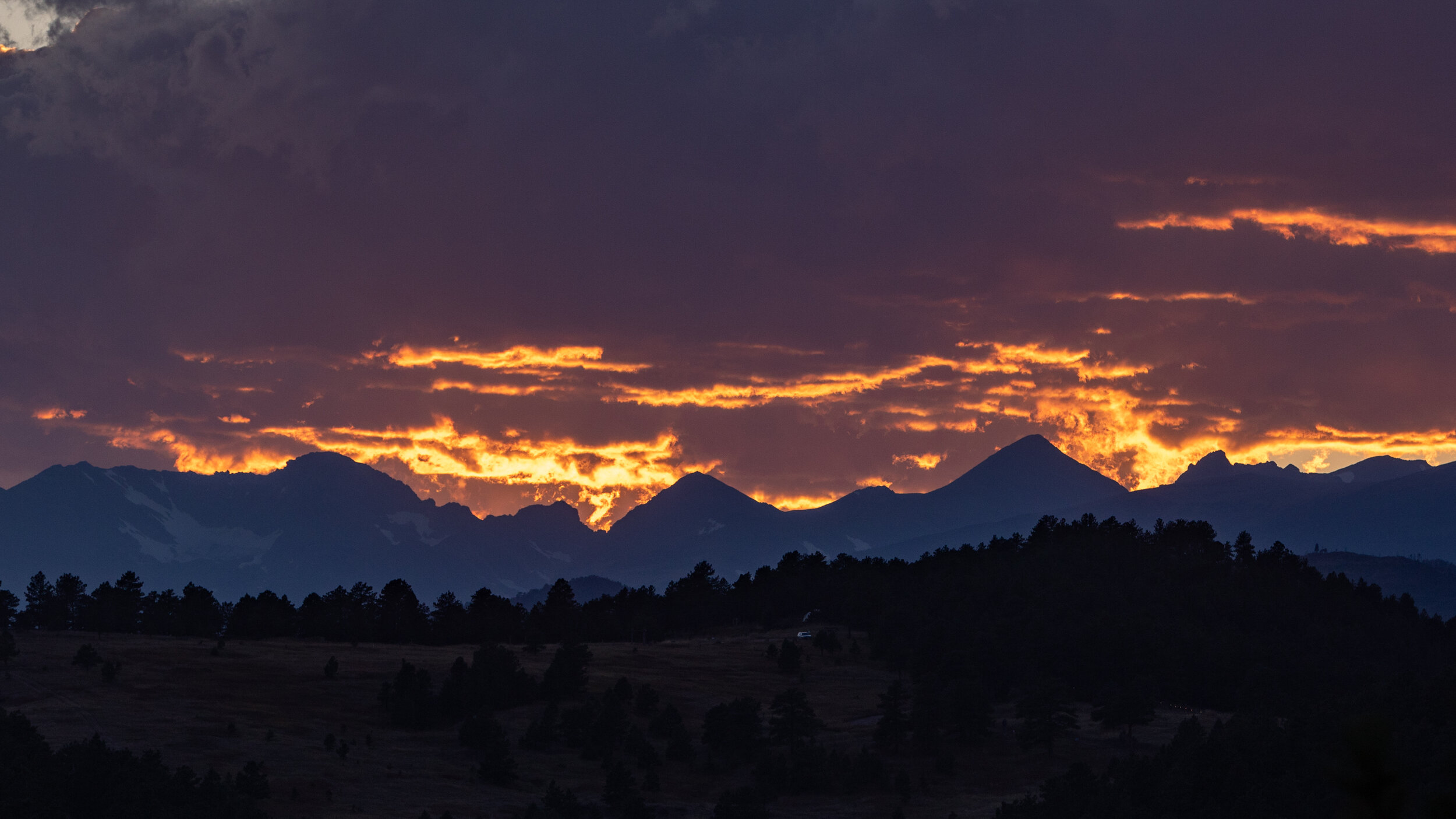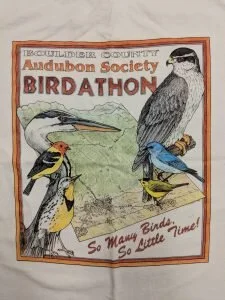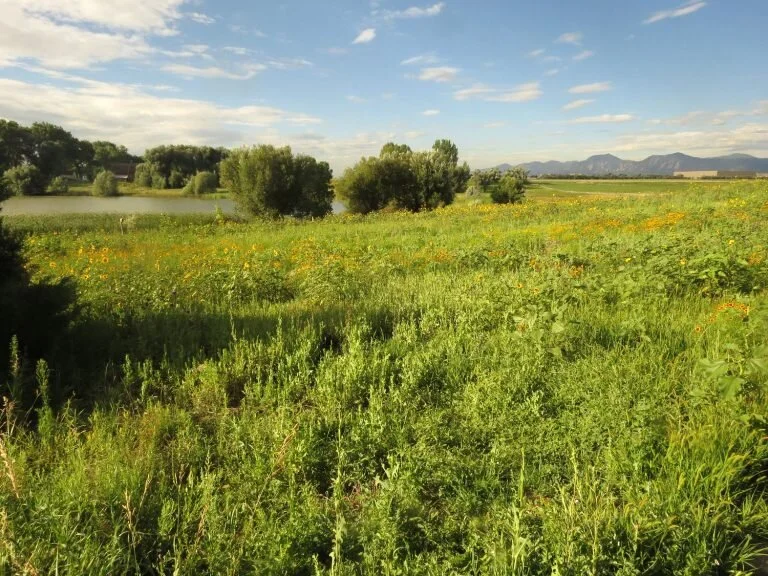
The BCAS Mission
The Boulder County Audubon Society is a voice for birds and wildlife conservation through habitat protection, advocacy, and nature education.
Through a wide variety of activities, Boulder County Audubon Society provides a platform for local action, education to generations young and old, and camaraderie for members interested in birds and wildlife conservation and observation. The Boulder County Audubon Society is an all-volunteer, nonprofit 501(c)3 corporation. Have questions? Continue to explore our website or contact BCAS.
Learn more about becoming a member of Boulder County Audubon Society.
The Boulder County Audubon Society is a nonprofit 501(c)3 corporation. Membership and gifts to BCAS are tax-deductible to the full extent of the law. Our Federal Tax ID number is 23-7170676.
BCAS: Mission-driven Throughout Its History
The Boulder County Audubon Society celebrates 50 years in 2022. Looking back over the decades, here are a few of the highlights from each.
1970s
A Daily Camera clipping of the first Boulder Audubon meeting with a presentation by Dr. Bock urging three facets to local environmental issues: research, education, and action.
Boulder Audubon was formed in the early 1970s as an affiliate of the National Audubon Society. The first monthly meeting and speaker series featured a presentation by Dr. Carl Bock, faculty at the University of Colorado, on February 23, 1971. Official status as a chapter of the National Audubon Society followed shortly after in June 1972. Boulder Audubon stepped into a community that already had a birdwatching group, the Boulder Bird Club, and the statewide Colorado Field Ornithologists. Both organizations continue to thrive today. Starting with only 30 charter members in 1971, the chapter grew to 286 members by June of the following year and by 1973 Boulder Audubon had ballooned to 450 members.
Grassroots activism was an important component of the chapter’s mission from the start. An organized telephone tree alerted members to participate in local land management issues and projects where these either threatened or encouraged wildlife habitat. Early initiatives included opposition to the proposed sale of Pawnee Grasslands to private ownership, support for the creation of Eldorado State Park, and support for the designation of the Indian Peaks Wilderness Area.
Image from Town & Country Review article of the 1977 Boulder Audubon winter solstice bird walk.
Our early meetings had a typical Boulder flavor (one old announcement reminds attendees to “please flatten all beer cans when attending the monthly meetings”) and were focused on conservation, recycling, and nature study. Members attended legislative hearings starting in these early days and continuing throughout the decades (banning the poisoning of predators, for example).
Then, as now, field trips and excursions to get Boulder Audubon members outdoors and observing birds and wildlife were an important function of the chapter and a way to forge camaraderie among community members.
Research and monitoring were also foundational to Boulder Audubon. Bird counts began in the 1970s to establish baseline data for the future (which is now!). The first Boulder Audubon participation in the venerable national Christmas Bird Count was in 1975; it has been held here almost annually since.
Christmas Bird Count Interlude
The first Boulder area Christmas Bird Count was on Christmas Eve 1910 during the 10th annual Bird Lore Annual Census, before they were known as the Audubon Christmas Bird Counts. This was the first count recorded for Colorado. Today there are approximately 50 Christmas Bird Counts in Colorado.
Here is the full record of that first count from Bird Lore, National Audubon Society’s official journal, edited by Frank Chapman.
The count list from the first Boulder area Christmas Bird Count. It is fascinating to see the changes to the English names of the species.
1980s
Conservation and understanding local wildlife and their habitats remained a core part of Boulder Audubon’s mission through the 1980s. In 1979, Boulder Audubon started monthly wildlife inventories, detailing monthly records of birds, mammals, and other wildlife observed in Boulder County. To conduct this monitoring, the county is divided into 50 areas and individuals reported what they saw each month in each area visited. The inventory has been useful in tracking populations of increasing and declining species over the last 40 years (and counting).
The community of bird and wildlife-focused organizations in Boulder county expanded in 1982 with the formation of the Boulder County Nature Association. It was formed to support Boulder County Parks and Open Space programs and to study, protect, and educate the community about the natural and cultural resources of Boulder County.
Boulder Audubon’s conservation efforts continued in the 1980s with efforts including refurbishment and continued monitoring of the Walker Ranch Bluebird Trail, in cooperation with Boulder County Parks and Open Space, during the late-1980s and into 1990s.
1990s
In 1994, Boulder Audubon Society officially changed to become Boulder County Audubon Society in recognition that our membership and important conservation issues draw from the entire county (and beyond).
Conservation initiatives continued throughout the 1990s. But these efforts don’t come cheaply. From the early 1990s until 2005, the spring Boulder County Audubon birdathon raised from $3000-$12000 each year to support conservation programs.
Over the decades, as the regional Open Space programs thrived and expanded, Boulder County Audubon worked with several other groups to monitor wildlife, protect special areas, and create bridges between recreationists and environmentalists. One of the most successful collaborations was among the City of Boulder Open Space Department, the Terra Foundation, Boulder County Nature Association, and our chapter to set aside acreage for wildlife along Coal Creek, with subsequent monitoring over 15 years to record changes systematically. Such studies are used by land management agencies across the west, and Boulder County Audubon members are proud to be a part of this.
The Coal Creek Project began in 1997 when Boulder County Audubon entered into discussions with the City of Boulder Open Space about fencing four linear miles of the Coal Creek riparian corridor south of Boulder to protect the area from cattle grazing and other intrusions. Bird surveys at 30 point-count stations were initiated in 1998. The Terra Foundation contributed the funds to pay for fencing, and fencing was completed in December 1999. Boulder County Audubon also raised $25,000 to contribute to the fencing but when these funds weren’t needed, the board voted to dedicate $14,000 to help pay for a video describing the project that was used for regional education efforts. Bird counts continued through the 2000s, documenting dramatic increases in numbers of shrub-nesting and cavity-nesting birds within the protected corridor.
2000s
Conservation initiatives continue to be an increasingly important part of the Boulder County Audubon mission after the turn of the 21st Century. In 2004, Boulder County Audubon started offering local memberships, distinct from National Audubon Society memberships, in order to continue to support local grassroots conservation and education programs.
Working with Audubon Colorado (now Audubon Rockies), Boulder County Audubon volunteers produced the Colorado Wildscapes book and gave lectures across the state about wildlife-and water-friendly gardening. The Wes Sears Wildlife Memorial Garden, based on the principles in the book and dedicated in September 2005, was planned and created by Boulder County Audubon members and members of the Boulder Universalist Unitarian Church, where it is located. You can still visit the curbside garden today before any of the Boulder County Audubon monthly programs.
In 2005, with the Walker Ranch Bluebird trail having again fallen into disrepair, Boulder County Audubon volunteers spearheaded an effort to again refurbish the nest boxes and carry out active monitoring. The program has been enormously successful, expanding to other “trails,” with dozens of boxes fledging hundreds of cavity-nesters, including the popular bluebirds.
2010s
As part of Boulder County Audubon’s commitment to native landscapes, we cooperated with Boulder County to restore the native prairie around Dodd Reservoir. Boulder County Audubon Society owns the property at the west end of Dodd Reservoir, which is an excellent local birding location, and the restored prairie improves its habitat quality for native species.
Education is a key component of conservation and Boulder County Audubon supports education for youth and the general public. These programs have included the Lafayette summer program in partnership with Eco-Arts Incorporated (creating natural history inventories and art with students frequently underrepresented in science and nature careers [2014–2016]) and the Boulder Reservoir summer ecology programs for elementary and middle school students (2013–2015). In 2013, Boulder County Audubon started the Teen Naturalist program to provide an opportunity for local teens to get together to learn about and enjoy birds, wildlife, and their habitats. Each year, Boulder Audubon provides two or three scholarships for Colorado youth to attend summer bird camps.
Today, as it was nearly 50 years ago, providing opportunities for community members to be active outside while enjoying and learning about wildlife and habitat remains an important activity for Boulder County Audubon Society. These opportunities include field trips for physically challenged birders, organized by Mary Balzer; regular, free local field trips to explore birding or wildlife hotspots throughout Boulder County; and Interludes with Nature trips that often take members further afield to learn about Colorado habitats and wildlife from regional experts.
For more than 30 years, volunteers have provided information to both Boulder Open Space and Mountain Parks (OSMP) and Boulder County Parks and Open Space to help shape their conservation planning. In the early 2000s, BCAS members served on committees and testified at public hearings during the often-contentious drafting of the Boulder OSMP Visitor Master Plan (approved in 2005). Boulder County Audubon members again stepped up to provide feedback and testify as Boulder OSMP updated its Master Plan, which was adopted in 2019. The inclusion of the Environmental Resources Element in the Boulder County Comprehensive Plan is based on work by Boulder County Audubon and the Boulder County Nature Association. Boulder County Audubon’s emphasis has been to create relatively large areas of protected habitat for wildlife and to regulate human recreational activities so as to reduce disturbance to native habitat and native species.
2020s
Boulder County Audubon maintains its focus on education, conservation, and advocacy while working to make birding, enjoying nature, and habitat conservation more inclusive for everyone in the community.








